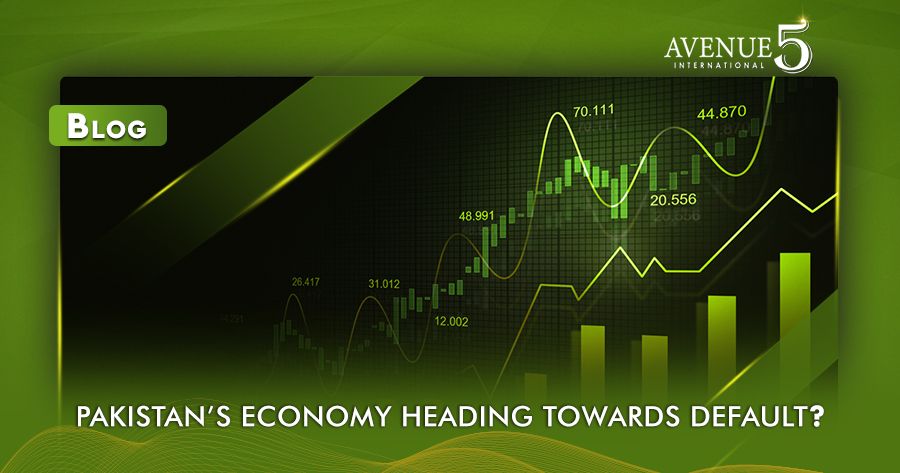
Pakistan’s Economy is in serious trouble, as seen by the rupee’s ongoing depreciation, record-high inflation, and balance of payment difficulties. Pakistan’s position is getting worse every day, just like it did recently in Sri Lanka. Because of Pakistan’s Economy and political unrest and neglect, Pakistan is in danger of defaulting. After reaching this extreme state of going into default, the administration has gone above and beyond to find a solution.
To help determine whether Pakistan is about to default on its debts or not, Avenue5 International will highlight the country’s existing debt problems.
Is Pakistan on the verge of default?
There are rumors that Pakistan is nearing default. But is it accurate to say that the country is also welcoming Sri Lanka’s economic fate?
In May, Sri Lanka’s foreign exchange holdings fell to a historic low. The nation ceased paying its debts, which led to a serious economic crisis. Sri Lanka had a large amount of foreign debt—more than $7 billion—that needed to be returned to different creditors this year.
However, its foreign exchange reserves were only worth $1.6 billion. As a result, they were unable to pay for the importation of the necessary commodities and settle their international debt.
Is Pakistan now on the verge of default? There is no genuine basis for the comparisons being made on social media between the current economic crisis and Sri Lanka’s.
In contrast to popular assumptions, the Pakistani administration will be able to resolve this issue. Despite assertions to the contrary from various economists, the government will be able to satisfy its $33.5 billion in external finance requirements this year, according to the acting governor of the State Bank.
Pakistan’s fiscal situation is significantly superior to that of Sri Lanka and other defaulting nations, the State Bank’s acting governor assured.
Pakistan’s Economy and Debt
The Pakistani rupee’s worth has significantly declined as the current exchange rate for the dollar has increased to Rs 235.44. Because of the chaotic swings in the currency markets and the declining foreign exchange reserves, which led to the devaluation of the rupee, investors are currently wary of their investments.
The Acting State Bank Governor recently forecasted that as the money starts to stream in from the IMF and other friendly countries, the rupee will stabilize at about 200 against the dollar.
According to the central bank, the country has $13 billion in total foreign exchange reserves, of which $9.2 billion are in the foreign exchange account and $3.8 billion are in gold. The central bank has a sufficient safety net to close the funding gap for this fiscal year in light of these figures.
How can Pakistan avoid going into default?
The State Bank of Pakistan (SBP) has to contradict the internet rumors that Pakistan has declared bankruptcy. Pakistan’s economic position is not as dire as is widely believed, and the government has been making tremendous efforts to avert any potentially disastrous crises. As follows:
Increasing Costs of Fuel and Gas
The Pakistani government raised the price of fuel and gas to stop the economy from going bankrupt and avoid more debt problems.
The government was able to reduce the likelihood that it will default in the future, similar to Sri Lanka, by taking this action. It is alleged that Sri Lanka was on the verge of defaulting, but no prompt action was done, which ultimately caused such a severe economic crisis.
Modular Exchange Rate
Let’s take a look at the scenario in Sri Lanka. When the economic crisis struck, they maintained an overvalued currency, which seriously jeopardized their economic and financial status.
Instead, Pakistan weakened its currency at the ideal time, which made managing the default risk simpler. Evidently, a good deal of the potential harm had already been stopped.
Economic and Financial Policies
In order to avoid widespread instability, the Pakistani government changed its macroeconomic policies by restricting imports during the economic crisis.
To lessen the number of imports coming into the nation, a ban on luxury items was put in place. The government of Pakistan purposefully set limitations on luxury items to reduce the rise in import costs despite the economy’s reliance on imported commodities.
Payment of Debt
Pakistan’s current debt is thought to be worth about $38 billion. The price of gasoline and fuel was raised by the government by 30 rupees per liter in the previous week in an effort to reduce the current debt burden.
Pakistan is in a much better position to pay off its debts and stabilize its economy, even though its payable debt is equal to that of Sri Lanka.
Bottom Line
Undoubtedly, Pakistan is experiencing a difficult economic position, and stabilizing the balance of payments and the ongoing price increase would take months.
To prevent the economy from going bankrupt and reduce the country’s current account deficit, the government must improve both its microeconomic and macroeconomic policies.
For more blogs stay tuned on Avenue5 International.
Visit BinTariq GOC if you want to know more about us and Times Square & The Dunes Mall for our projects information.

